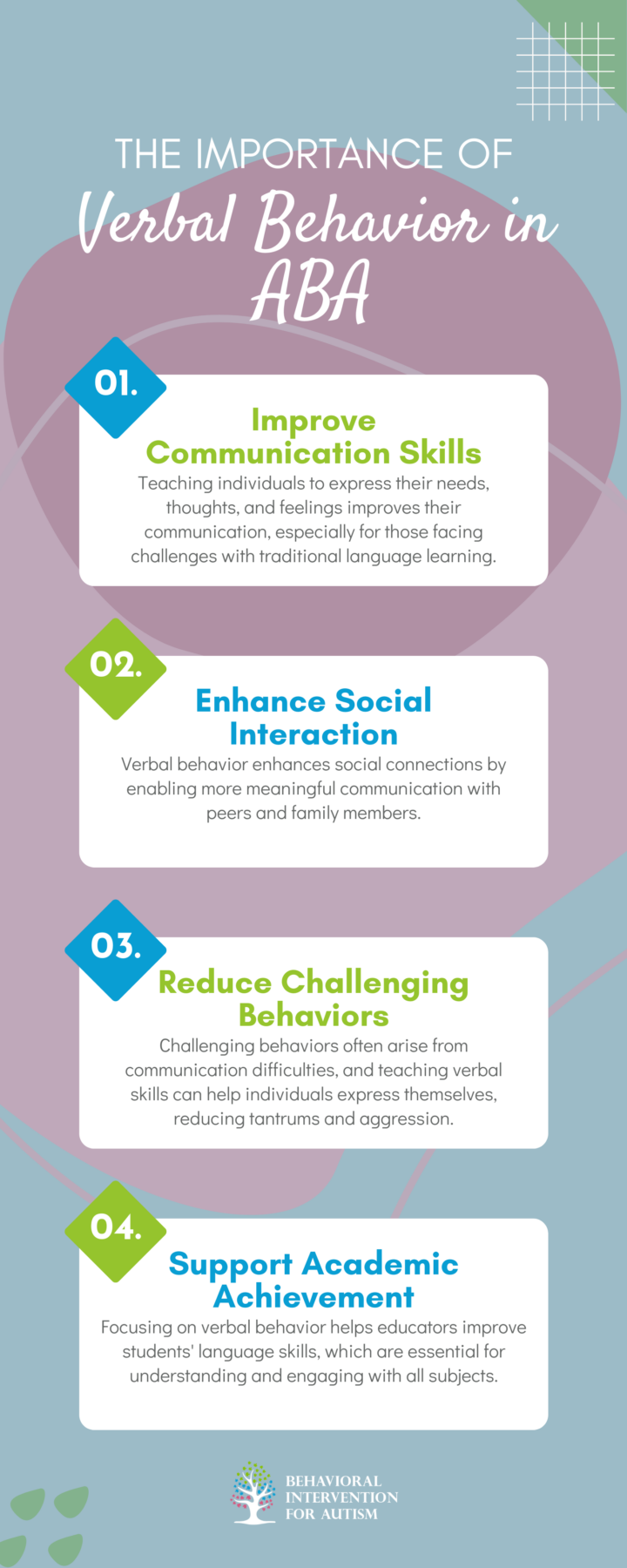
Table of Contents
Verbal behavior is a crucial component of Applied Behavior Analysis (ABA), particularly in the context of working with individuals with autism and other developmental disabilities. Understanding verbal behavior involves more than just recognizing spoken language; it encompasses a broad range of communicative behaviors and emphasizes the function of language in social interactions. This article will explore the principles of verbal behavior, its importance in ABA, and effective strategies for implementing verbal behavior interventions.
What Is Verbal Behavior?
Verbal behavior, a term popularized by B.F. Skinner in his seminal work “Verbal Behavior,” refers to any behavior that involves communication through language. Skinner categorized verbal behavior into different types, each defined by its function rather than its form. This approach shifts the focus from the structure of language to its purpose, allowing practitioners to analyze how language is used in social contexts.
In verbal behavior, communication can be broken down into the following categories:
- Mand: A request made to obtain a specific item or action. For example, saying “water” when thirsty.
- Tact: A comment or label that describes an object, event, or action. For example, saying “dog” when seeing a dog.
- Echoic: Repeating what someone else has said, which involves verbal imitation. For example, saying “hello” after someone greets you.
- Intraverbal: A response to another person’s verbal behavior that does not involve a direct request. For example, answering the question “What is your name?”.
- Textual: Reading written words aloud. This does not require understanding the content but involves vocalizing text.
- Transcription: Writing down spoken language. This is the written counterpart of echoic behavior.
Understanding these categories is essential for developing effective communication skills and tailoring interventions to meet individual needs.
The Importance of Verbal Behavior in ABA
Verbal behavior plays a vital role in the lives of individuals with autism and other developmental disorders. Language and communication are fundamental for social interaction, education, and personal development. By focusing on verbal behavior, practitioners can help individuals:

Implementing Verbal Behavior Interventions
Effective implementation of verbal behavior interventions requires a structured approach, often referred to as the Verbal Behavior Approach (VBA). Here are some key strategies:
1. Conduct a Functional Assessment
Before implementing verbal behavior interventions, it’s crucial to assess the individual’s current communication skills and needs. A functional assessment helps identify:
- Current Communication Levels: Determine which types of verbal behavior the individual currently demonstrates and which areas need improvement.
- Motivating Operations: Understand the individual’s preferences and what motivates them to communicate. This will help tailor interventions to increase engagement.
2. Use Naturalistic Teaching Methods
Natural Language Acquisition (NLA) is a crucial aspect of the VBA, emphasizing learning language through natural interactions. Techniques include:
- Incidental Teaching: Utilize everyday situations to encourage spontaneous communication. For example, if a child points to a toy, the adult can wait for the child to ask for it verbally before providing it.
Natural Environment Training (NET): Create opportunities for communication in real-life settings, allowing the individual to practice language skills in a meaningful context.
3. Reinforce Verbal Behavior
Positive reinforcement is essential for encouraging verbal behavior. Strategies include:
- Immediate Feedback: Provide praise or rewards immediately after the individual demonstrates the desired verbal behavior. This reinforces the connection between the behavior and the positive outcome.
- Natural Reinforcers: Use items or activities the individual values as reinforcers. For example, if a child requests a snack, providing the snack serves as a natural reinforcer for using language.
4. Teach Each Category of Verbal Behavior
Focus on teaching each category of verbal behavior systematically. This can be done through:
- Direct Teaching: Introduce each type of verbal behavior separately and provide opportunities for practice. For instance, teach mands by presenting a preferred item and prompting the individual to request it.
- Modeling: Demonstrate appropriate verbal behavior and encourage imitation. For example, model a tact by labeling objects in the environment.
5. Create a Structured Environment
A structured environment helps facilitate learning. Considerations include:
- Visual Supports: Use visuals such as picture exchange communication systems (PECS) to support understanding and encourage communication.
- Clear Expectations: Set clear and consistent expectations for communication in various settings, whether at home, in school, or in social situations.
Understanding verbal behavior in ABA is essential for enhancing communication skills and promoting social interactions among individuals with autism and other developmental disorders. By focusing on the function of language and employing effective teaching strategies, practitioners can empower individuals to express themselves, connect with others, and engage more fully in their environments.
The principles of verbal behavior provide a robust framework for addressing communication needs, ultimately improving the quality of life for those who may struggle with traditional forms of communication. Through dedicated efforts, we can foster a world where every individual can share their voice and participate meaningfully in their communities.
Verbal behavior ABA is a powerful approach that focuses on enhancing communication skills in individuals with autism. By teaching functional language and effective communication strategies, we empower our clients to express their needs and interact more meaningfully with the world around them.
Our ABA programs in Florida are tailored to each individual’s unique needs, ensuring personalized attention and support. At Behavioral Intervention for Autism, our dedicated team utilizes evidence-based practices to deliver high-quality services that foster growth and independence. If you’re interested in discovering how our programs can make a difference in your child’s life, reach out to us today!
- 9 Common Obsessions of Children With Autism You Should Know - February 25, 2025
- What is Neurodiversity? A Guide to Embracing Differences - February 25, 2025
- Understanding Hyperfocus in Autism: What It Means and Why It Happens - February 25, 2025
